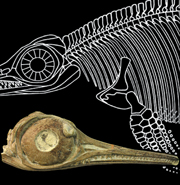Ichthyosaurs are iconic fossils, first discovered 200 years ago by Mary Anning on the Jurassic coast of Dorset at Lyme Regis. Hundreds of specimens of these dolphin-shaped predators have since been found, and they were abundant and important predators in Jurassic seas. The new study shows, however, that Mary Anning’s Jurassic ichthyosaurs were actually a much-reduced remnant of the former glory of the group.
Ichthyosaurs originated in the Early Triassic, 250 million years ago, and during the Triassic they became hugely varied in adaptations. Triassic ichthyosaurs ranged in length from 0.3 to 20m, and in shape from long and slender to deep-bodied. The giant shonisaurids of the Late Triassic were whale-sized, 20m (60ft) long and may have fed on shoals of squid by gulping them down with their massive mouths.
All this came to an abrupt halt at the end of the Triassic, 200 million years ago, when a mass extinction devastated life on land and in the oceans. This crisis was caused by massive volcanic eruptions as the Atlantic Ocean began to open up between Europe and North America. The volcanic gases caused flash heating and loss of oxygen in the oceans.
It had always been known that only three or four species of ichthyosaurs survived this devastating event, but everyone had assumed that the ichthyosaurs bounced back successfully to recreate their former important position in marine ecosystems.
However, the Bristol research indicates that this was not the case. Using numerical techniques, the researchers explored the range of adaptations seen in ichthyosaurs from the Triassic (250-200 million years ago), and Jurassic (250-145 million years ago). They found that, while there were as many species present in the Jurassic as in the Triassic, their range of shapes and sizes was only about one-tenth of what it had formerly been.
The research was carried out by Philippa Thorne as part of her work towards the Masters in Palaeobiology degree, which she received in February 2011. Philippa worked in collaboration with Dr Marcello Ruta and Professor Michael Benton, both in the School of Earth Sciences at the University of Bristol.
“We applied a set of demanding numerical approaches to a data set that contained character codings for all major Triassic and Jurassic ichthyosaurs,” said Philippa. “These methods allow us to explore rates of character change through time, and to compare the amount of variation in all aspects of the body shape and adaptations of different groups and different times. We were amazed at the result.”
The researchers have been able to show that ichthyosaurs passed through the evolutionary bottleneck of the end-Triassic mass extinction and they recovered their former diversity, but their evolutionary breadth of form had been cut drastically.
“This was completely unexpected,” commented Dr Marcello Ruta. “Everyone knows that the Early Jurassic ichthyosaurs were so dominant in the seas – after all hundreds of beautiful specimens have been found over the past 200 years. However, it turns out that these were all very similar in form, and were all apparently doing the same thing, ecologically speaking.”
“This work shows how mass extinctions can re-set the whole pattern of evolution,” said Professor Mike Benton. “Life recovers after these crises, and numbers may bounce back, but our new methods allow us to explore in detail what’s really going on.”
Palaeontologists have already discovered that disparity (the range of morphology of organisms) often expands first, and diversity (the number of species) second. In this case, the opposite seems to be the case, with species numbers rising in the Early Jurassic, but with little expansion of disparity at all.
“The work will be extended to other marine groups of the Mesozoic to see whether all aspects of the marine ecosystems were knocked sideways by the end-Triassic mass extinction,” said Dr Ruta. “This is a great start, and wonderful work by one of our students.”
